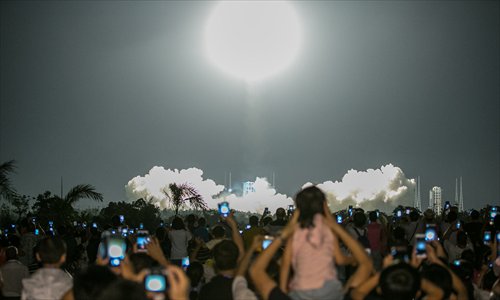HOME >> CHINA
Wenchang launch center thrusts tourism industry skyward
Source:Global Times Published: 2016/6/30 21:03:00

Tourists and locals cluster on a viewing platform in Wenchang to wait for the flight of the rocket. Photo: IC
With a gentle glow permeating the sky, over 20,000 space enthusiasts, tourists and locals clustered on eight viewing platforms around China's newest rocket launch site in Wenchang, South China's Hainan Province - mostly on the city's beaches - and waited for the maiden flight of the Long March-7 carrier on Saturday as the night closed in.
In a cloud of white smoke, the rocket ascended against the dark sky, trailing a vast column of flame at 8 pm on the northeastern corner of China's southernmost island.
Similar to the US' Kennedy Space Center in terms of its low latitude, climate and tourism resources, Wenchang Satellite Launch Center, dubbed China's Cape Canaveral, is the first spaceport open to the public and has boosted the area's previously struggling tourism industry.
Less secretive
China's three other launch bases are located in sparsely-populated inland areas - Jiuquan in northwestern China's Gobi desert, Xichang in the Daliang Mountains of Southwest China's Sichuan Province and Taiyuan on the Loess Plateau in Shanxi Province. Wenchang was specially selected for its low latitude: only 19 degrees north of the equator.
The lower the latitude, the larger the earth's centrifugal force, which means that rockets have a longer service life and launch costs are lower.
Wenchang's latitudinal advantages allow the carrier rocket's payload to be increased by more than 300 kilograms, 7.4 percent more than at any of the other three centers. That translates into a saving of $6 million each launch. The current average world price for rocket payload is about $20,000 per kilogram, the Xinhua News Agency reported.
Satellites launched from low latitudes are also expected to have a longer service life as a result of the fuel saved by having a shorter journey into geosynchronous orbit. That extra fuel can later be used to regulate and sustain orbit.
Besides, coastal Wenchang can receive deliveries of large spacecraft parts by sea, the only feasible channel to transport rockets measuring over 3.5 meters in diameter, while the other launch centers are all landlocked in remote plateau and mountainous regions that can only be reached by rail.
In spite of Hainan's geographical advantages, the then governing body of China's launch centers - the now-defunct Commission of Science, Technology and Industry for National Defense - once frowned at its partner that researched and manufactured rockets and satellites - the Aviation Industry Corporation of China - for proposing a spaceport at Wenchang, recalled Zhang Guobao, former deputy head of National Development and Reform Commission, the body in charge of spacecraft development.
To dismiss the commission's worries that the costly and hard-to-establish Xichang launch center would decline if the Wenchang center was built, it was suggested that Xichang and Wenchang take on distinct roles, Zhang was quoted by the China Economic Weekly as saying in June. "For instance, commercial launches can be conducted in Wenchang whereas military ones can be conducted inland."
"Spaceports should not be mysterious any longer during China's vigorous promotion of the reform and opening-up, but a multi-functional base featuring science popularization, scientific research, sightseeing and spacecraft launches," Zhang said.
Revival of tourism
As the Jiuquan, Taiyuan and Xichang space centers have not been opened to the public, the 20-square kilometer Wenchang Satellite Launch Center includes a space-science theme park to attract space enthusiasts, in addition to a command center, a launch site and a rocket assembly plant.
In key workshops for rockets and spacecraft, windows have been installed for visitors to see engineers at work. They can also tour designated zones at the launch site, Zhou Fengguang, deputy chief engineer of Xichang Satellite Launch Center who participated in designing and constructing the Wenchang complex, told the Beijing Evening News on Saturday.
Boosted by the space project, the city has boomed and now boasts 256 hotels and inns, as well as 2,132 restaurants. The eight outdoor viewing platforms can accommodate 50,000 spectators, according to the city's publicity department.
It is hoped that the influx of tourists will revitalize the once-prosperous city that boasts China's Great Barrier Reef - Yunlong Bay - and the Dongjiao coconut grove.
The area's tourism industry gradually sank into oblivion in the 1990s when the province's rail system bypassed Wenchang while running through Haikou and Sanya, which both later became renowned coastal resorts, Hainan-based news site hinews.cn reported.
Fu Yuezhu, a 40-year-old villager in Longlou township where the launch center is located, used to have an unstable income from raising frogs and planting rice and peanuts. But now she works in a hotel cafe, earning a monthly salary of over 2,000 yuan ($301). She has moved from a small house into a three-story building, and now rents out the first floor to shops for 7,200 yuan a month, the Economic Daily reported on Sunday.
In 2015, Wenchang received about 1.7 million domestic and overseas tourists, which generated about 1.2 billion yuan in revenue, Xinhua said.
Newspaper headline: Rockets boost town
Posted in: Society